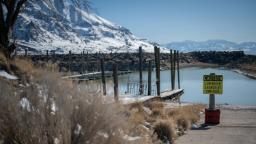CNN
—
It was only three months ago that nearly three dozen scientists and conservationists sounded the alarm that the Great Salt Lake in Utah faces “unprecedented danger” – unless the state’s lawmakers fast-tracked “emergency measures” to dramatically increase the lake’s inflow by 2024, it would likely disappear in the next five years.
Now, after an incredible winter full of rain and snow, there is a glimmer of hope on North America’s largest terminal lake, where water levels had fallen to a record-low last fall amid a historic, climate change-fueled drought across the West.
As of Thursday, the snowpack in the Great Salt Lake basin was more than double the average for this time of year.
All of this winter’s rain and snow that fell directly into the Great Salt Lake increased the water level there by three feet. And while that “feels like an answer to prayers,” said Benjamin Abbott, a professor of ecology at Brigham Young University and lead author of the January report, experts have cautioned that one good winter is not enough to save the iconic lake.
In reality, the precipitation only made up for what was lost to last year’s drought and evaporation.
“Unfortunately, that doesn’t substantively change the timeline we described in our January report,” Abbott told CNN.
“If we play our cards right and shepherd more of the snowmelt to Great Salt Lake, this could buy us another two years. On the other hand, if we go back to business as usual, we could be back at an all-time low 18 months from now.”
To reverse the decline, the Great Salt Lake needs an additional 1 million acre-feet of water – roughly 326 billion gallons – per year, according to the January assessment.
Bonnie Baxter, the director of the Great Salt Lake Institute at Westminster College and one of the authors of the January report, said the state would “need another five years like this in order to get the system healthy again.”
“If I do the math, we got about three feet of direct precipitation that fell into the lake this year, that is fantastic,” Baxter told CNN. “But the last two years, we also lost 2.8 feet in the summer, and we expect to lose that three feet in the desiccating summer. So now, we’re pretty much even, and that’s not a good place to…
Click Here to Read the Full Original Article at CNN.com – RSS Channel – HP Hero…

